President's Message
Happy 300th birthday Meadow Farm!
In 1713, William Sheppard acquired the property of Meadow Farm by land grant. Not much is known about the use of the property, until William’s great-grandson, Mosby Sheppard, built the existing house in 1810. Later the property was acquired by Dr. John Mosby Sheppard. seven generations of the Sheppard family lived at Meadow Farm. In 1957, Elizabeth Adam Crump, wife of the late Adjutant General of Virginia, Sheppard Crump, donated the property of Meadow Farm to the County of Henrico; and it was opened to the public as Meadow Farm Museum/Crump Park in 1981, as a living history museum depicting life in the 19th century.
To help celebrate the occasion, efforts have been made to locate Sheppard descendants to honor the family. What a rich legacy the Sheppard family has provided for the citizens of Henrico County.
Recently, while re-organizing the HCHS office, I located files on contributions other families have made to Henrico history:
- Mrs. Burlee of Tree Hill Farm served as Christmas Mother
- Sons of Henrio that were killed in WWII, first missing action and then the terrible news of their tragic loss of life
- Mr. W. H. Ferguson, manager at Curles Neck who later became the Board of Supervisor for the Varina District in 1936
- Family businesses that provided services for the economy of Henrico county. One story was a thank you to a young man and his horse who delivered mail during a particularly deep snow. The horse and rider fell at one point, but the article was pleased to report neither was injured.
These stories are the threads that create the fabric of our history. Won’t you share your family history with us? If you have your family genealogy or stories of a particular interest, we wou;d love to hear from you. We can be contacted at hchsinfo@yahoo.com or by calling (804)839-2407.
HCHS, in partnership with Henrico Division of Recreation and Parks, will be recreating Richmond’s homefront in 1863, by having dinner with Jefferson Davis, portrayed by interpreter Bill McCourty, at Walkerton Tavern, 2892 Mountain Road, Glen Allen, VA 23060. If you would like to experience historical; authentic food while listening to period music, please join us on Friday May 24, 6-8. Cost is $20.00.
Also, as part of the Richmond homefront weekend, a bus tour of Confederate cemeteries will depart from Dabbs House on Saturday, May 25, 10 a.m.- 3.p.m. A box lunch will be provided. Cost is $20.00.
Registration is required for one or both of these events. For information, call (804)652-3409. Registration forms can be found on the HCHS Shopping page at www.henricohistoricalsociety.org/shopping.html. Payment can also be made by Paypal.
The dinner at Walkerton is the second in a series of dinners with historic figures. Last year’s dinner with General Robert E. lee was most informative and enjoyable. Seating is limited, so please get your registration in promptly. We would be pleased to see you there!
Best wishes,
Sarah Pace,
President
>Back to Top<
"Drilling Down" Through Maps
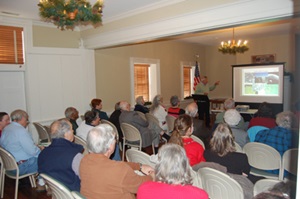
Charles “Chuck” Peple presented “Exploring history with GIS” at the HCHS December meeting. GIS, a computer mapping system that allows the creation of layers of information based on land maps and aerial photography, was integral to his search for New Bridge and Strawberry Hill Plantation and in defining Civil War battlefield areas of intense conflict.
>Back to Top<
APHA Meets at Farmer's Rest
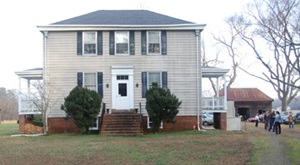
The Association for the Preservation of Henrico Antiquities got to see one of its preservation projects in progress. The association had helped conduct the search to find a buyer interested in preserving and restoring farmer’s Rest, a nineteenth-century property in Varina. That new owner hosted the APHA’s January meeting and showed them through the house and around the grounds.
>Back to Top<
Young Historians Recognized
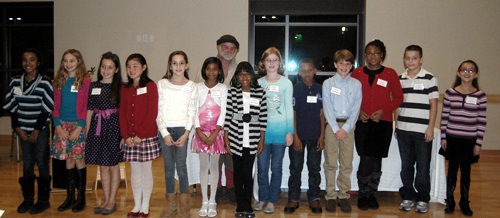
Fifteen Henrico fifth-graders were honored for their essays on historical topics at the 10th Annual Historical Awareness Project Awards Reception, held Nov. 29 at the Eastern Henrico Recreation Center. After the ceremony, the winners posed with historical interpreter Lindsay Gray.
The Winners:
Brookland District
Anne Thill, Marcus Rand, and Logan Anderson
Fairfield District
Aare’n Johnson, Treasure Bailey, and Justin Cooke
Three Chopt District
Audrey Lowe, Sarah Bender, and Gretchen Neary
Tuckahoe District
Lia Deasy, Aliana Ayala Davis, and Davis Buckbee
Varina District
DeAyra Oliver, Chris Bolden, and Daija Tyler
>Back to Top<
A Request for Help
Meadow Farm is celebrating its 300th anniversary of the original land grant this year, and they are looking for Sheppard descendants.
Pam Greene at the Henrico County Division of Recreation and Parks is doing research for this. She is asking for anyone who may have a connection to contact her at gre10@co.henrico.va.us.
>Back to Top<
New Light on Old Stoneware
Rob Hunter, Editor of Ceramics in America, left a message and posted a link in the HCHS’s Facebook page. He wrote, “Henrico County citizens may want to be aware of this important exhibit of American stoneware made in the County during the 19th century. It is one of the most important stoneware complexes in America.”
In June of 2008, the HCHS Newsletter article, “Local Nineteenth Century Stoneware,” dealt with the Henrico potters of the James River school of pottery. Those artists are gaining increasing recognition, and they have become the subject of a special exhibit of the Museum of Early Southern Decorative Arts in Winston-Salem, North Carolina.
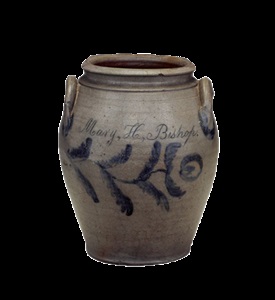
Curated by Mr. Hunter, along with Kurt Russ, Oliver Mueller-Heubach and Marshall Goodman, “From Kaolin to Claymount: Demystifying James River Valley Stoneware” adds to the understanding of these potters. MESDA’s web exhibit of the stoneware (www.mesda.org) claims that “Transcending their status is utilitarian objects, these pots, many exhibited here for the first time, provide a remarkable record and a unique glimpse into a significant and long-lived concentration of pottery manufacturing in eastern Virginia. Viewed collectively, they present a bold decorative aesthetic rivaling long-recognized and celebrated schools of production seen elsewhere in the commonwealth and the Nation.”
Our earlier article identified Benjamin DuVal as instrumental in fostering the growth of the stoneware industry in the area, and his operation in Richmond was important. But it is interesting that the very prominent Randolph family had an important role in establishing pottery production in Henrico County.
Richard Randolph and a partner purchased a dilapidated mill on Four Mile Creek in 1806. Repairing the mill was cost prohibitive, so he turned “Norwich Mills” into a stoneware factory and later name the site “Kaolin” after the find clay found there.
Apparently, his first potter was Henrico County native Samuel Frayser, who, after his employment with Randolph, operated independently from about 1824 until he died in 1849.
Thomas Amoss, a member of a prominent Baltimore Quaker potting family, was another Randolph potter. he worked with Frayser from 1818 to 1821, when the two began to work independently. Thomas died in 1823.
Stephen Booker Sweeney may have trained under Frayser. In 1838, he bought land on the James River. he continued acquiring land and named his holdings, which included several kilns and a house that doubled as a hotel, “Clayount.” In 1854, he acquired the lands where the first Randolph, Amoss, and Frayser potteries had been located. Sweeney died in 1862 and is buried in Oakwood Cemetery in Richmond. For more detailed treatment of these James River potters and images of stunning examples of their work, visit MESDA’s website.
Storage jar inscribed “Mary H. Bishop”
Attributed to Samuel Frayser at the former Richard Randolph Manufactory or the Frayser Pottery (after 1824)
Four Mile Creek, Henrico County, Virginia
1821-1849
Salt-Glazed Stoneware
www.mesda.org
>Back to Top<
Maria Mason Tabb Hubard’s Diary Chronicles Two Years of Love, Loss, Cannons, and the Confederacy
Diaries give us insight into our culture, human nature, history and so much more, and they raise a number of questions. Why do people keep them? Who do they think will read them? Do the entries record an immediate experience and reaction, or are they recorded after some thought and consideration of who might be reading them?
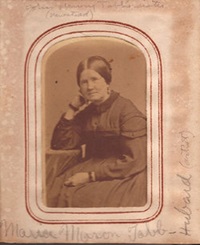
In the case of the diary Maria Mason Tabb Hubard kept between May 10, 1860 and August 16, 1862, we get those insights; we wonder about the first two questions; and the answer to the last question seems to be “both”.
She was the wife of the artist William James Hubard, and they had a “country home” in the Sydney area of what is now Richmond but was then Henrico County. William was an Englishman and an artist known mainly for portraiture. After a trip to Italy, he turned to sculpture and had a foundry on his property. On January 14, 1853, he was given exclusive license by the Virginia General Assembly to make bronze copies of the marble statue of George Washington by French sculptor Jean-Antoine Houdon, producing a total of six. During the Civil War Hubard turned his foundry into a munitions foundry to cast guns for the Confederacy.
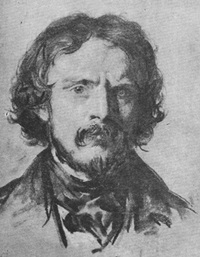
It was during this time that his wife Maria kept a diary, and in this diary we find the mundane details of daily life, an eerie foreshadowing, outpourings of emotions in near poetic language and expressions of heart-breaking grief - some clearly written in the moment, and others apparently composed at some later time.
Her diary is at the Virginia Historical Society (Mss5:1H8615:1) and the following transcriptions have been taken from that document with her spelling and emphasis maintained.
April 18th 1861 The day it was proclaimed publicly that Virginia has seceded from the Union of the United States, and had become a Sovereign and independent State!!! This day was also the anniversary of April 18th 1859, to me the most memorable day because it was the most miserable one of my whole existence! May God in mercy grant it may never be repeated to me.
At her “Rose Cottage” in Sydney, Maria raised strawberries, and her diary gives accounts of strawberry prices and sales. She regularly complains about the weather and the necessity of donning various undergarments in late spring and early summer. Then there is an incident at the foundry that elicits an entry that will prove to be nearly prescient.
July 4th 1861...On yesterday July the 3rd heard of another shocking accident from the manufacturing of fulminating powder for percussion caps, the second death that has occurred in [from it - this is crossed out] this city from the same cause, poor young Laidley was the last victim, having an arm & his head blown off causing instant death! oh how shocking! and what a warning to all who handle any explosive, or igniting powder, and I am in constant dread of my precious Husband being injured during some of his chemical experiments.
July 11th 1861 Thursday. Williams cast the first Brass Cannon that was ever cast in his Washington foundry! Oh how my heart leaped with joy, that he had at last succeeded after his toil and difficulties he had to encounter, in raising the money these war times, necessary for such an expense.
July 20th 1861. Saturday Williams cast his second Brass 12 pounder to day about twelve o’clock.
Maria’s intense loyalty to the Confederacy, as seen in this account’s first entry, is evident when she concludes her July 21, 1861, entry, responding to an account she had received of the battle at “Mannassas Gap:”
God grant them strength to utterly rout and drive the vile hordes of the tyrants Lincoln & Scott from our soil forever.
Saturday, July 27th 1861. William cast his third Brass Cannon! Ella, Emmy Crump & myself were present and witnessed the process, though very interesting, it did not compare with the Statue casting in the afternoon.
Maria’s love for her husband was as ardent as was her love for the South, and her language could fly just as high when she wrote of him.
Thursday, August 8th, 1861...This afternoon when my precious husband came out of the garden, up stairs into our chamber, bearing in his dear hands, the most beautiful rose I ever saw, and....presented it to me; at the same time throwing his arms around me, and pressing his lips to mine, saying, “This is all love I have to give you this year I am so poor” I felt that I would not have exchanged it for a diamond of the same size, for as a love token from him. Its “price was, above Rubies,” and I would also freely give my worthless life to strew his pathway with flowers, and free it from cares of every kind, oh! how ardently did I wish, that his every want only be supplied, and his ambition gratified, that he might “Win a wreath of Fame and write on Memories scroll a deathless name.” Few people have had more of the up’s and down’s of life than ourselves, in struggling through poverty, the loss of four lovely children, and all the little disappointments of life, yet for Twenty five years of our married life, I may say, we never had a jar or doubt or suspicion of wrong one to the other.
More accounts of cannon casting continue with hopes of each one being perfect. Problems noted with them begin after the casting of the fourth when she notes:
“he has had so much Trouble, distress of mind, his other three having been rejected as they had holes in them.”
Wednesday August 14th 1861 “to day William finished the miniature of Captain Perry, a most charming acquaintance we have made lately...he had this miniature taken for his wife.” [he had received “orders to go to the Battlefield.”]
Tuesday, September 10th 1861 this day chronicles a singular event in my life, that of taking in, or rather assisting in work, that was taken in for which remuneration was to be received!! [A woman, A.E. Thompson, who stayed with her from time to time until she “gets another home” took orders to produce clothes for the Confederate troops, but two of them worked on two pairs of pantaloons, finished them the next day and only got 37 ½ per pair. Maria would not let her do it again.]
Thursday. September 30th 1861. this is my 48th birth day, and William is going to celebrate it by casting his eighth Cannon, and if it is permitted by Government will honor me by calling it after me! Most sincerely do I trust it may be a perfect one in every respect.
Accounts of castings, both successful and unsuccessful, continue, and on Friday, October 4, 1861, she writes:
this afternoon William cast his 9th Cannon. God grant it may prove a perfect one, and that it will complete his contract for the State Government work, and that he will then be enabled to make them on his own book entirely!”
He had contracted to produce four.
Wednesday October 9th 1861. William cast his 10th Cannon and Captain Gibbon of the Confederate Ordnance department and his wife, came out to witness the operation. This is the first Confederate gun he has cast, the Government having given him a contract to fill for making ten Cannon for them”
Saturday, November 16th 1861. This morning poor little Temple was buried! and Ella & I really wept as much as though he was some relative instead of a poor slave. What would the Northern Abolitionist say could they have witnessed the scene? Ella made bouquets, they followed the hearse and Maria planted “several hyacinth roots.”
Friday, November 22nd 1861. William made a purchase of vital importance to him of a Lathe Engine, which I trust will enable him to hasten the completion of his Cannons.
Thursday, February 13, 1862. would prove to be a nightmarish confirmation of her fears of a potential accident. Having finished housekeeping, she was up in “her accustomed room,” and
my darling husband came over five or six times, during the morning, always coming to my room, seem’d restless and he asked her to walk with her in the garden. He came over to dinner before I was down, and he seemed worried. It was so he ate unusually heartily, and left the dining room and went straight to his room, and I to the storeroom to drain off some whiskey he had requested me to bottle off. Just as I had finished, at about 4 oclock p.m., I heard an awful explosion of a shell over at his room!! I ran to the back door, and just as I reached it I heard another scream! I rushed through the alley oh! God! how shall I tell it. I saw my idolized husband coming out of his gate, his hair standing up high all over his head, his face bleeding in various places, particularly about his eyes & cheeks, his dear hand stretched out on eather side shattered & bleeding!!! the doctor was sent for and “amputated the first joints of his three fingers & thumb”...how I prayed for his life to be spared to me, and I was foolish enough to believe God would hear such prayers from a poor sinner like me, because in his holy word he had promised, “Whatsover thou askest in prayer believing I will grant, and so my prayer was, not they will be done, but Lord spare his life to me - and so he heard me not.
William died on Saturday, February 15, 1862, with his wife, two children and Mary Crump at his side. But the above entry is curious, not for the earlier foreshadowed event alone, but particularly for her conclusion - “so he heard me not”-two days before her husband’s death. Clearly, she recorded this some time after the 15th, yet she writes a dramatic account as if it were written in the emotion of the moment.
She doesn’t write again until Friday, March 27th 1862, and all through April and May of that year entries invariably record thoughts on her husband. By June, her entries seem to reflect her earliest notes.
June 18th 1862 Wednesday - sent out my last strawberries, 2 plates for which I got $1 per plate more than I ever did before!!!
Later, she and her daughter Ella boarded a “Packet Boat for Lynchburg.” There are visits to various other places, including Natural Bridge and Virginia Military Institute, where her son had gone. It was there that her memories of her husband were once again stirred.
July 23rd 1862. Wednesday [i] soon reached this very imposing building, of this far famed Military Institute and oh, how my heart palpitated, and swelled to bursting when my eyes rested upon the noble statue of the immortal Washington, the work of his dear hands, oh! the tumult of thought that rushed over me, the cares, the anxieties, then the full complete joy we shared at its completion. Oh! my God, my God why was it so ordered that we must be severed?

Maria would live to the age of 75, but Hubard’s property was confiscated by the United States Government after the war, and she and her two children returned to Gloucester, her birthplace. She died in Abingdon on October 22, 1888. She and her husband are buried in Hollywood Cemetery.
We can thank her for the view she gives of life during the Civil War, and we can regret that the love and use of such highly expressive language seem to have lost much of their importance in age of “tweets.” But her language and the apparent lag between event and record make us wonder if she didn’t suspect that someone later on would be reading these thoughts. If so, she was right, and we should be glad she did.
Sydney, location of Hubard’s “Rose Cottage’ Detail of Smith’s 1853 Map of Henrico County (Sydney outlined at top left)
The Hubbard Family
Maria Mason Tabb Hubard (Far left)
William James Hubard (center)
Their children, Ella and Lloyd Tabb Hubard (right)
>Back to Top<
How to Roast a Shad

It’s March and the shad are running up the James River to spawn. A traditional Virginia dish, shad are often eschewed by many because of the bones. However, that didn’t keep Virginia cook Mary Randolph from including the following recipe for shad in The Virginia Housewife.
Fill in the cavity with good forcemeats, sew it up, and tie it on a board of proper size, cover it with bread crumbs, with some salt and pepper, set it before the fire to roast; when done on one side, turn it, tie it again, and when sufficiently done, pull out the thread, and serve it up with butter and parsley poured over it.
From her recipe for a roast turkey, she says:
Make the forcemeat thus: take the crumb of a loaf of bread, a quarter of a pound of beef suet shred fine, a little sausage meat or veal scraped and pounded very fine, nutmeg, pepper, and salt to your taste; mix it lightly with three eggs.
>Back to Top<
Now You Know
They are plain and fancy utensils for Feeding the Hungry and Helpless
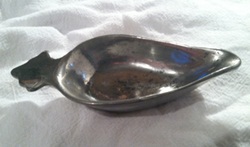
Feeding infants and invalids has always presented a challenge - a challenge met with the utensils in the accompanying images.
The simple pewter vessel on the left is an eighteenth-century pap boat used to feed babies. The Oxford English Dictionary suggests that the term “pap” may have derived from the Scandinavian word for the sound made when a baby opens his mouth for food. Recipes for pap usually called for bread, flour and water. The pap could also be enhanced with butter and milk, or cooked in broth.
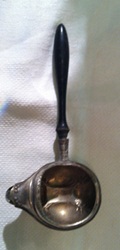
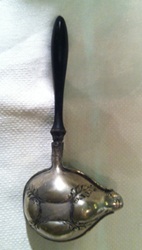
A century later, feeders had gotten fancier. It seems as if the Victorians had elaborate tableware for every possible use and type of food. This tendency even extended to the feeding of invalids, as evidenced by the accompanying photographs. They are different views of a decorated silver invalid feeder with a wooden handle.
>Back to Top<
What Do You Know?
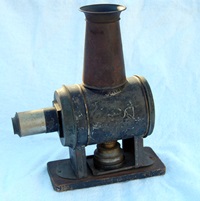
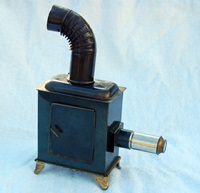
The items at the right are used for the same purpose. The object on the left is black metal with brass feet. It is 8” tall. The object to the far right is also black metal (rather worn) on a wooden base. It is 11” tall.
Do you know what they are?
Email your answers to jboehling@verizon.net.
>Back to Top<
News 2013: First Quarter
Second Quarter | Third Quarter | Fourth Quarter
Home | Henrico | Maps | Genealogy | Preservation | Membership | Shopping | HCHS
|











